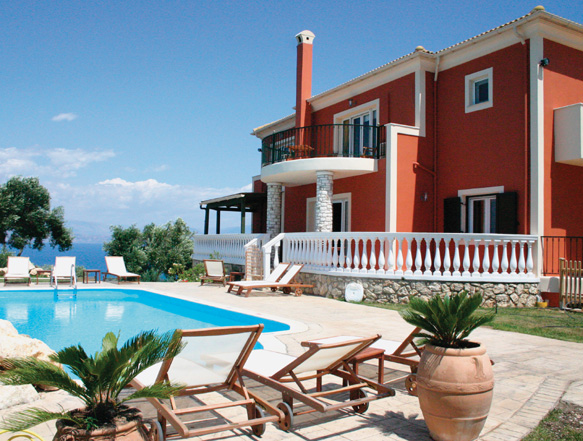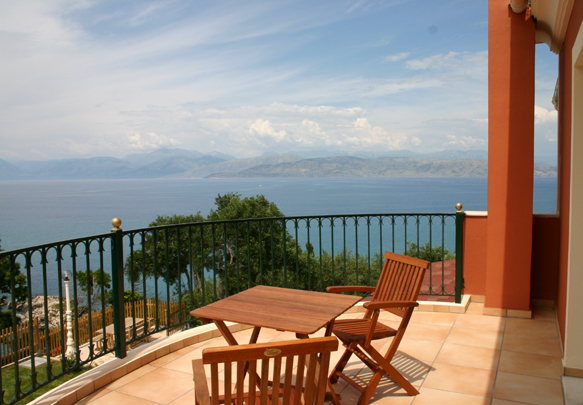Corfu, Greece (2007)
The Enchanted Island
Happy memories of a 1971 family trip to the Greek island of Corfu prompted us to return again thirty-six years later with Marnie and her family.
|
|
Corfu - 1971 Corfu - 2007
In summer of 1971, our family spent a wonderful holiday on the Greek island of Corfu, where we were joined by Val’s mother, the unforgettable Nana the First, for the week. We stayed in a hotel in Corfu Town and spent our days exploring the island, swimming in the sea and playing canasta in the hotel lobby with Nana. Fast forwarding to the spring of 2007, Val and I returned to Corfu for a holiday with Marnie, her husband, Whit, and her two children, Duncan and Ellierose. Ellierose, going on five, was just a year younger than Marnie when we first discovered Corfu. It was like going back in time, a nostalgic return to thirty-six years ago.
We rented a large, five bedroom villa, known as the St. Nicholas Beach House, in the village of St. Spiridon, on the north coast of the island. Perched on top of a low cliff and surrounded by an ancient olive grove, the villa enjoys some absolutely stunning views of the sapphire sea below and the snow capped mountains of Albania in the distance. From our balcony we could watch a steady procession of ferry boats and cruise ships gliding their way past our house through the Kerkyra Straits from their Adriatic ports on the Italian and Dalmatian coasts. The eye-opening views of this spectacular, 270 degree panorama from our bedrooms each morning made it hard to stay in bed.
The villa was equipped with every possible convenience even swings and a sandbox for the kids and a pool table and workout room for the adults. But its most spectacular feature was its large, heated 20 x 40 foot swimming pool on the veranda overlooking the sea below. We had other swimming options as well. From the house, it was just 130 steps down a steep stairway to a private, pebbled beach below our house from which we could swim out to a nearby island. Or just short walk down our driveway through the surrounding olive groves, where three tethered donkeys quietly carried out their lawn care duties, took us to one of the many sandy beaches that are strung along Corfu’s northern shores. Fringed with tamarisk trees and with a vast stretch of shallow sea and white sand, it was a lovely spot for swimming.
 |
 |
Our Rental Villa Perched Above the Ionian Sea St. Nicholas Beach House
Corfu is one of Greece’s most popular islands, located just off the western coastlines of Greece and Albania in the Ionian Sea at the entrance to the Adriatic Sea. At its closest point it is just two scant miles from the Albanian mainland. Corfu is a mountainous island, forty miles long and twenty miles wide, with spectacular landscapes, long golden sandy beaches, traditional villages, ancient fortresses, Byzantine churches and some lively resorts along the coastline.
Described by a former British Consul as a place with “exotic scenery, magical colors, flaming sunsets, romantic moonlight, luxurious vegetation, radiant flowers, centuries old silver olive groves, scented lemons, sleepy lagoons, forgotten coves, exciting caves, virgin beaches, golden sands and turquoise emerald seas”, it’s not hard to understand why we chose to return to this enchanted island.
The island of Corfu has a rich history. Its myths and legends date back to the Greek god Poseidon, who cavorted with a sea-nymph named Korkyra from whom the island got its name. (In Greek, the island is called Kerkyra). In Homer’s epic tale the Odyssey, Ulysses stopped at the island near the end of his travels following the Trojan Wars. Jason and the Argonauts also came to Corfu in their quest for the Golden Fleece. William Shakespeare’s last play “The Tempest” is also said to have been set in Corfu, at the beautiful beach at Paleokastritsa.
Corfu’s long history includes domination by the Corinthians, Macedonians, Romans and Byzantines. In more recent times the island has been occupied by the Sicilians, the Venetians, the French and the British. The Republic of Venice controlled Corfu for four hundred years until the start of the 18th century. The Italians returned once again to occupy the island during World War II. The legacy of these earlier occupations remains in the form of castles and fortresses that exist in strategic locations all over the island.
Corfu Town. . Built between two massive fortresses which guard the port, Corfu Town is the island’s principal city, housing thirty thousand of the island’s one hundred thousand plus residents. Many consider it to be one of the most beautiful cities in all of Greece. Constructed during the Venetian era, the town has a unique Italianesque charm, which reminded me a lot of Naples. Val and I spent our first two days in Corfu Town, to witness the celebration the Greek Orthodox Easter in Corfu Town.
|
|
Monticanissi (Mouse) Island - Symbol of Corfu Old Venetian Fortress - Corfu Town
Easter in Corfu is unique with visitors coming from Athens and all over Greece to participate in the celebrations, which begin on Palm Sunday and continue throughout the week. There are colorful processions accompanied by uniformed marching philharmonic bands, fireworks, cannon fire, church services and ringing bells. The most unusual event of Easter weekend occurred at 11 am on Saturday morning when the calm was shattered by a glorious pealing of all the church bells while showers of earthenware pots and vases, some filled with water, are thrown from thousands of windows and balconies into the streets below, much to the delight of the locals and the bewilderment of us tourists. Symbolizing good luck for the following year, it is a custom celebrated only in Corfu but may be something we may want to try back in Minnesota in the future.
Nicholas Bay House. From Corfu town we drove north along the coast about twenty five miles to St. Spiridon where we were joined by Marnie and her family in our rental villa arriving on Saturday night. Fortunately, the Easter bunny proceeded us to the house and left a trail of Easter eggs (all in a traditional deep red) in the garden for the kids to find on Easter morning.
Our days at the villa were centered around the pool and the sea. Duncan and Ellierose were in the pool three or four times a day while the rest of us lazed at poolside, swimming, sunning and reading. In between dips, we were kept busy playing pool and chess with Duncan and throwing water balloons and reading stories with Ellierose. In the evenings, we ventured out into the nearby villages for a sampling of Greek food at one of the local tavernas.
One of our more adventurous days took us along some narrow, winding roads over the mountains to the beach at Paleokastritsa, one of the most scenic beaches in all of Greece. We had fond memories of swimming there during our first visit and, although the beachfront town has been highly developed over the ensuing thirty six years, we were among only a few brave souls to take a swim in the sea that early in the season. Of course, we are from Minnesota! We concluded our visit with a boat ride out to several of the adjacent beaches and caves, including the cave where Ulysses is said to have been nursed back to health following his shipwreck
Our most memorable afternoon, though, was drive up to the mountain village of Old Perithia, an ancient town which, just a generation ago had over 2,400 inhabitants until most of them left to find work in the tourist businesses on the coast. This left only a few locals remaining behind in the old town, including a tavern owner, who operates a family restaurant which has been in business there for one hundred and forty years.
The six of us dined there under a grape arbor on an outdoor patio, which we had all to ourselves except for three resident cats, who strolled about under the tables. We all agreed that it was the best dinner that we’d had during our week on Corfu. The meal began with an assortment of starters (mezethes) which included: fried cheese, wild greens (horta), sautéed pork, leek pie, sausage and olives. We each chose different main courses – lamb, rabbit, kebobs and pasta with meat chunks (pastitsatha). Since the next day was Marnie’s birthday, the tavern keeper offered a complimentary walnut cake and we finished with a rousing Greek toast (Yiamas!) to the birthday girl.
Albania. Gazing across the sea every day from our villa to the nearby Albanian coast, convinced us to try to arrange a visit to this mysterious country. Long isolated from the rest of the world by a despotic Communist ruler, who sealed its borders to all Western nations, it threw off its Communist past in just the past fifteen years and has a long way to go to catch up with the rest of Europe as a result of its long and notorious isolation.
 |
View from our Balcony Overlooking Albanian Coast 6th Century Early Christian Baptistery - Butrint, Albania
It proved relatively easy to arrange the visit. A passenger ferry runs every day between Corfu Town and the Albanian coastal town of Saranda. Before leaving, we were able to arrange for a local Albanian guide, who met us upon arrival and drove us in his Land Rover to the nearby archeological site at Butrint, one of least known and, therefore, one of the least spoilt of the classical archeological sites of the Mediterranean.
Inhabited continuously for over forty thousand years since the Bronze Age, Butrint has been a center of European civilization since it was established as a fortified city in the 7th century B.C. First excavated by the Italians between 1928 and 1940, the site includes a Roman marketplace and bath, a remarkable early Christian baptistery, a 6th Century Byzantine basilica, some perimeter walls and towers and a fine collection of marble statues. More recent excavations have uncovered a classic Greek amphitheater seating up to twenty-five hundred, some gorgeous mosaics from a Roman palace and several Venetian towers.
With only fifteen percent of the area having been excavated, a walk through the wooded site provided continuing surprises as we came upon amazing archeological wonders at every turn or clearing. It was like a large, open-all museum spanning layer upon layer of ancient history, each bearing witness to Butrint's colorful past.
On the return trip to Corfu, our boat was followed by a pod of dolphins, which frolicked in the wake and leaped high out of the sea. It was a good luck omen and clearly a special invitation for us to return to the enchanted island of Corfu again some day.